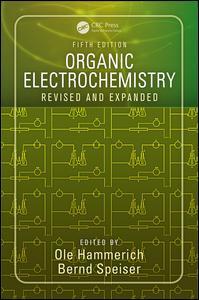Description
Organic Electrochemistry (5th Ed.)
Revised and Expanded
Coordinators: Hammerich Ole, Speiser Bernd
Language: English
Subjects for Organic Electrochemistry:
Keywords
Anodic Oxidation; Radical Anions; buckminsterfullerenes; Radical Cation; electroenzymatic synthesis; Electrochemical Reduction; electrosynthesis of bioactive materials; American Chemical Society; organic electrochemistry; Aryl Halides; Electrochemical reactions; Undivided Cell; Electron transfers; Electron Transfer; Electrosynthesis; Cathodic Reduction; Reaction intermediaries; Ionic Liquids; Reaction mechanisms; Cyclic Voltammetry; NH Ph; Hg Cathode; Ph Ph; Electrochemical Oxidation; Half Wave Potentials; Enol Ether; Heterogeneous Electron Transfer; Homogeneous Electron Transfer; Oxidation Potential; Endohedral Metallofullerene; Cyclic Voltammograms; Organic Halides; Reductive Coupling
1712 p. · 17.8x25.4 cm · Hardback
Description
/li>Contents
/li>Readership
/li>Biography
/li>
Praise for the Fourth Edition
"Outstanding praise for previous editions?.the single best general reference for the organic chemist."
?Journal of the Electrochemical Society
"The cast of editors and authors is excellent, the text is, in general, easily readable and understandable, well documented, and well indexed?those who purchase the book will be satisfied with their acquisition."
?Journal of Polymer Science
"?an excellent starting point for anyone wishing to explore the application of electrochemical technique to organic chemistry and?a comprehensive up-to-date review for researchers in the field."
?Journal of the American Chemical Society
Highlights from the Fifth Edition:
- Coverage of the electrochemistry of buckminsterfullerene and related compounds, electroenzymatic synthesis, conducting polymers, and electrochemical fluorination
- Systematic examination of electrochemical transformations of organic compounds, organized according to the type of starting materials
- In-depth discussions of carbonyl compounds, anodic oxidation of oxygen-containing compounds, electrosynthesis of bioactive materials, and electrolyte reductive coupling
- Features 16 entirely new chapters, with contributions from several new authors who also contribute to extensive revisions throughout the rest of the chapters
Completely revised and updated, Organic Electrochemistry, Fifth Edition explains distinguishing fundamental characteristics that separate organic electrochemistry from classical organic chemistry. It includes descriptions of the most important variants of electron transfers and emphasizes the importance of electron transfers in initiating various electrochemical reactions. The sweeping changes and lengthy additions in the fifth edition testify to the field?s continued and rapid growth in research, practice, and application, and make it a valuable addition to your collection.
FUNDAMENTALS AND METHODS. Basic Concepts. Techniques for Studies of Electrochemical Reactions in Solution. In Situ Spectroelectrochemistry of Organic Compounds. Surface Techniques. Application of Digital Simulation. Theoretical Calculation of Reduction Potentials. GENERAL PREPARATIVE ASPECTS. Preparative Electrolysis on the Laboratory Scale. Application of Ionic Liquids, Emulsions, Sonication, and Microwave Assistance. Combinatorial Electrochemistry and Miniaturization. Relations between Micro- and Macrophenomena. ELECTRON TRANSFERS AND CONCERTED PROCESSES. Influence of Molecular and Medium Effects on Two-Electron Processes. Electrochemically Driven Supramolecular Devices. Proton-Coupled Electron Transfers. Dissociative Electron Transfers. Electron Transfer-Catalyzed Reactions. ORGANIC ELECTROCHEMICAL REACTION TYPES. Cleavages and Deprotections. Reductive Coupling. Oxidative Coupling. Oxidative Substitution and Addition Reactions. Fluorination. ELECTROCHEMICAL CONVERSIONS OF ORGANIC COMPOUNDS. Electrochemistry of Fullerenes, Derivatives, and Related Compounds. Aliphatic and Aromatic Hydrocarbons: Reduction. Oxidation of Hydrocarbons. Activation of the Carbon-Halogen Bond. Aliphatic and Aromatic Halides: Conversions. Oxygen-Containing Compounds: Alcohols, Ethers, and Phenols. Sulfur-, Selenium-, and Tellurium-Containing Compounds. Aliphatic Nitrogen-Containing Compounds: Amines, Amino Alcohols, and Amino Acids. Aromatic Nitrogen-Containing Compounds. Reduction of Nitro Compounds and Related Substrates. Reduction of Aldehydes, Ketones, and Azomethines. Reductions of Carboxylic Acids and Derivatives. Oxidation of Carboxylic Acids and Derivatives. Heterocyclic Compounds. Organoelemental Compounds. Organometallic Compounds as Tools in Organic Electrosynthesis. STEREOCHEMICAL AND BIOLOGICAL ASPECTS. Electrosynthesis of Bioactive Materials. Stereochemistry of Organic Electrode Processes. Electroenzymatic Synthesis. Electrochemical Modeling of Biological Processes. SURFACE CONFINED SYSTEMS. Electrochemistry of Conducting Polymers. Surface-Bound and Immobilized Molecules. SPECIAL APPLICATIONS. Electrogenerated Bases and Nucleophiles. Electrocatalytic Hydrogenation.
Ole Hammerich is an associate professor in the Department of Chemistry, University of Copenhagen, Denmark, where he received his Ph.D. in 1974 and has taught since 1975. His research interests include kinetics and mechanisms of organic radical ion reactions, charge-transfer complexes, and electropolymerization. He is the author or coauthor of more than 110 articles, papers, and book chapters and was, together with Henning Lund, the editor of the fourth edition of Organic Electrochemistry. He was also, with Jens Ulstrup, editor of Bioinorganic Electrochemistry. He served as the National Secretary for Denmark and as the Molecular Electrochemistry chairman in the International Society of Electrochemistry. He is a member of the Danish Electrochemical Society and the Electrochemical Society.
Bernd Speiser is an “auβerplanmäβiger Professor" in the Institut für Organische Chemie, Universität Tübingen, Germany, where he teaches courses in organic chemistry and molecular electrochemistry. He received his doctoral degree in Tübingen in 1981 and finished his habilitation in 1990. He was a Heisenberg fellow of the Deutsche Forschungsgemeinschaft from 1992-1996. His research focuses on the elucidation of reaction mechanisms of organic, organometallic, and inorganic compounds with experimental methods and computer simulations. He has published more than 140 papers, communications, and book chapters. He was the founding chair of Division 6 ("Molecular Electrochemistry") in the International Society of Electrochemistry and is a member of the Electrochemical Society, the International Society of Electrochemistry, the Society of Electroanalytical Chemistry, the Gesellschaft Deutscher Chemiker (GDCh), and DECHEMA Gesellschaft für chemische Technik und Biotechnologie.
These books may interest you

Modern Electroorganic Chemistry 52.74 €



